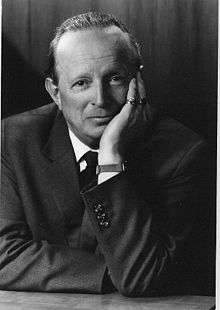Wichard von Alvensleben
| Wichard von Alvensleben | |
|---|---|
 Wichard von Alvensleben | |
| Born | May 19, 1902 |
| Died | August 14, 1982 (aged 80) |
| Nationality | German |
| Occupation | Agriculturist, Wehrmacht Officer |
Wichard von Alvensleben (May 19, 1902 – August 14, 1982) was a German agriculturist, Wehrmacht Officer, and Knight of the Order of Saint John. Alvensleben was the commander of Wehrmacht troops stationed in April 1945 at Bozen, from whence he led his troops to liberate the prisoners being held by the SS at Tyrol.
Early life
Alvensleben was born on May 19, 1902, in Wittenmoor (now part of Stendal) to Ludolf Udo von Alvensleben (1852–1923) and Ida, née von Glasenapp (1866–1924). He was taught in various convent schools at Magdeburg in Brandenburg an der Havel and passed his Abitur in 1921 at the Klosterschule Roßleben. After four years of practical training he commenced studies in agriculture, forestry, and law in Eberswalde and Munich.
In 1927 Alvensleben married Cora von Erxleben and started to work at his wife's country estates at Tankow-Seegenfelde in the district of Friedeberg and at Dertzow in the district of Soldin, New March, in 1929. In 1936 he bought the forested estate of Viarthlum, in the district of Rummelsburg, Farther Pomerania. Alvensleben by now had two daughters, born in 1934 and 1936, and was a Knight of Justice of the Order of Saint John as well as a deeply religious Christian.
Military Service
In 1939 Alvensleben became an Officer of the German Wehrmacht, earning the rank of Captain, and was deployed in Poland, France, Russia, Africa, and Italy. He was wounded in 1941 in Russia and received various decorations, including the Wound Badge, the Infantry Assault Badge, and the Iron Cross 1st Class. His wife committed suicide at the arrival of the Soviet Red Army on January 29, 1945, in Tankow-Seegenfelde.
In late April 1945 a group of 140 high-status prisoners were transferred to Tyrol, guarded by SS troops. A delegation from the prisoners contacted senior German army officers, made known the identity of the high-status prisoners, and conveyed the apprehension that those prisoners were to be executed. A regular German army unit under the command of Captain von Alvensleben moved in to protect the prisoners. Outnumbered, the SS guards moved out, leaving the prisoners behind.[1] The prisoners were then set free, with the majority taking sanctuary for a time in Pragser Wildsee until the arrival of U.S. troops.
After the War
In autumn 1945 Alvensleben was released from U.S. custody and started to work as a transport operator in a sugar refinery in Nörten-Hardenberg. In August 1946 Alvensleben married Astrid von Brand (widowed von Brockdorff-Ahlefeldt) and in 1952 he became an administrator of the von Brockdorff estate Ascheberg near Plön. In 1956 Alvensleben was involved with Diakonisches Werk, a charity organisation of the Lutheran Church at Rendsburg. He retired in 1974 and died on August 14, 1982, in Ascheberg.
See also
External links
Literature
- Hartmut Jäckel: Menschen in Berlin. Stuttgart, München 2001, S. 46-48.
- Hans-Günter Richardi: SS-Geiseln in der Alpenfestung. Bozen 2005